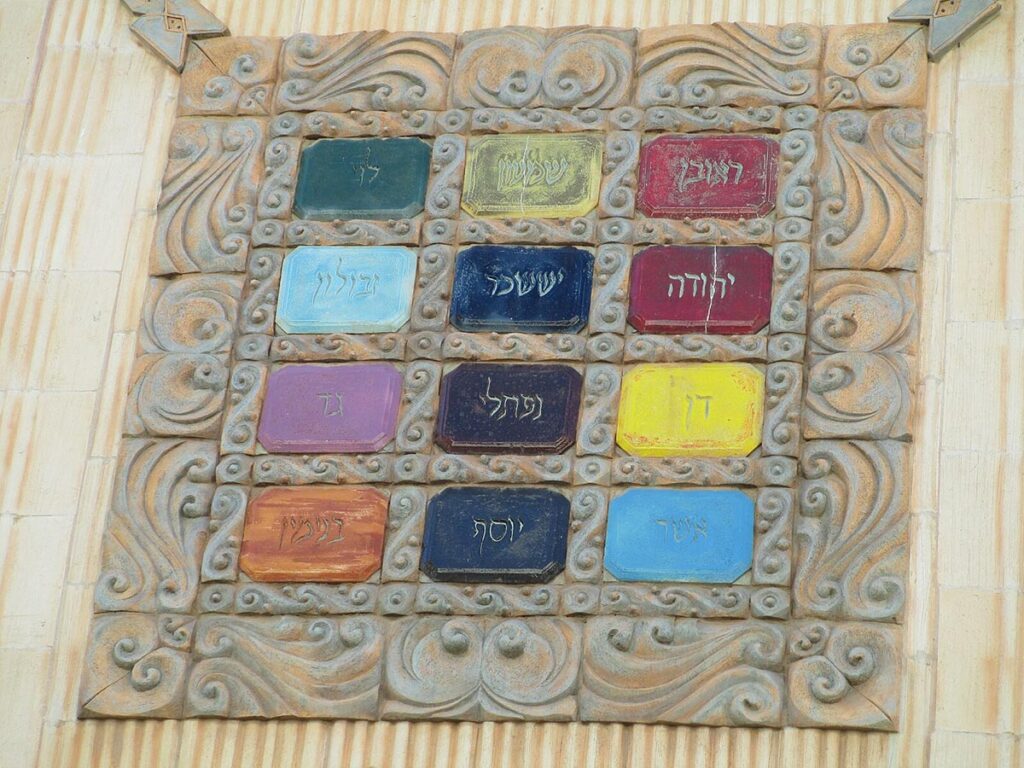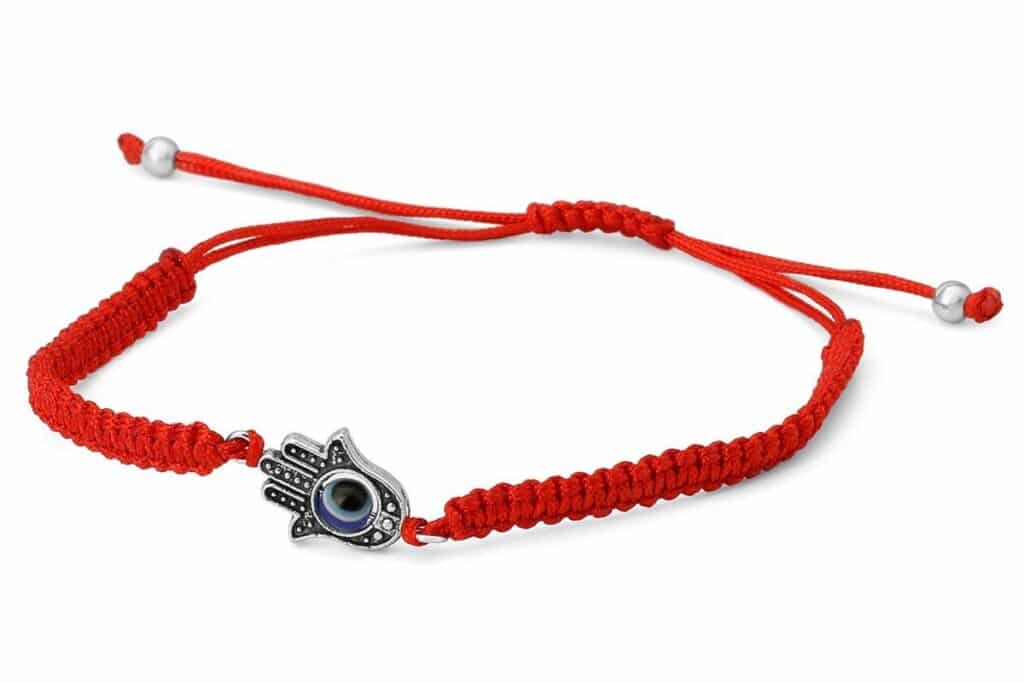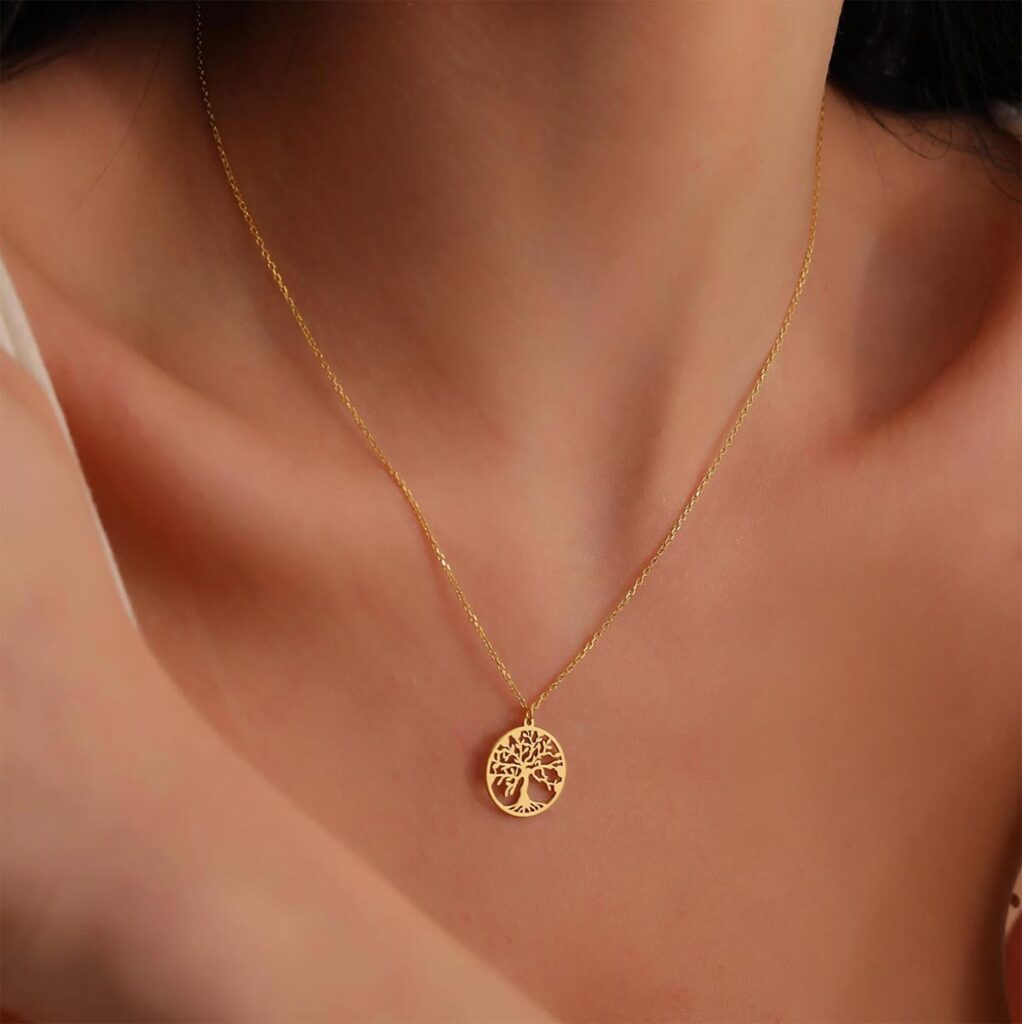
Jewelry is a canvas for personal style and self-expression. Beyond aesthetics, jewelry can also carry profound symbolic meaning and even take on a unique mystical dimension. When it comes to Jewish jewelry, this is certainly the case.
Jewish jewelry is made up of symbols that represent religious, cultural and spiritual elements. Whether it’s a Star of David, Hamsa, or a red string bracelet, each piece is a connection to Jewish heritage.
Let’s unpack the mystical symbolism that makes Jewish jewelry so special. Here are seven of the most popular Jewish jewelry symbols explained.
The Biblical roots of Jewish jewelry
To fully appreciate the symbolism of Jewish jewelry, we need to go back to the earliest days of Judaism, where jewelry played a significant role as both a sacred symbol and a part of everyday life.
In the Torah, a notable mention of jewelry is Aaron’s breastplate. In Shemot/Exodus 28: 2-4, God commands the priests (kohanim) to wear distinctive clothing “for honor and for beauty.” The chapter meticulously describes this breastplate adorned with 12 precious stones, each representing one of the 12 tribes of Israel.

This breastplate isn’t just for aesthetics but has a spiritual purpose. “Aaron shall carry the names of the children of Israel on the breastplate of decision over his heart, when he enters the sanctuary, for remembrance before the Eternal God at all times,” Exodus 28:29 states.
Another example relates to the story of the golden calf. According to the midrash (Pirkei d’Rabbi Eliezer 45), to construct this idol, Aaron demanded the Israelite women give up their jewelry. He instructed the men to forcibly take jewelry from their wives and daughters, but the women staunchly refused.
In ancient times, jewelry was also exchanged as a token of love and devotion, and as a symbol of status and wealth. For instance, in Beresheet/Genesis 24:22, when Abraham’s servant Eliezer met Rebekah at a well, he gave her gold nose rings and bracelets as a gesture to signify her selection as Isaac’s intended wife.
Additionally, Shir HaShirim, or the Song of Songs, traditionally attributed to King Solomon, contains numerous references to jewelry gifted as an expression of love and admiration.
The Star of David (Magen David)
Within the world of Jewish jewelry, the Star of David, known in Hebrew as “Magen David,” is one of the most universally recognized.
Its mystical significance in Judaism can be traced back to Kabbalistic (Jewish mystical) teachings. In the 13th and 14th centuries, Jewish scholars from Spain, Eastern Europe, and the Middle East delved deep into the esoteric dimensions of Jewish spirituality, laying down the foundational principles of Jewish mysticism.
An early 14th-century Spanish work, “The Book of Boundary,” illustrated the six-point star as featured on the “Shield of David.” This shield, a mystical protective amulet believed to have been used by King David, was said to possess powers that could repel spirits and demons.

From a Kabbalistic perspective, the star symbolizes unity and harmony between the divine and earthly realms. The two interlocking triangles represent the profound bond between God and the Jewish people. The six points of the star signify the six days of creation, while the center stands for the sanctified day of Shabbat.
Historically, the Star of David also has a somber element. In Nazi Germany, Hitler decreed that all Jews under the Third Reich wear a yellow Star of David — one of the most enduring images of the Holocaust.
But the Jews who survived did not let Hitler decide their symbol’s legacy. In the aftermath of World War II, they reclaimed their star, which ultimately became the symbol of the Jewish state’s national flag.
Today, many view the star as a testament to the enduring spirit of a people who have faced immense challenges and adversity throughout history, yet continue to wear their symbol with pride.
The Chai symbol
If you’ve ever been to a Jewish celebration (or listened to the song “I’ve Gotta Feeling” by the Black Eyed Peas), you’ve heard the word “chai.” In Hebrew, “chai” translates to “life,” and expressions incorporating this word are deeply embedded in Jewish culture.
Take for example, “L’chaim,” which means, “to life!” and serves as the Jewish equivalent of the celebratory “cheers!” Or “Am Israel Chai,” meaning “The People of Israel live.” This triumphant Jewish phrase celebrates the Jewish people’s resilience and survival through challenges.
In Hebrew numerology, or Gematria, each letter has a specific numerical value. “Chai” consists of two letters: Chet (ח) and Yud (י), with Chet representing the value of 8 and Yud signifying 10; their combined value is 18. For this reason, the number 18 holds a special place in Jewish tradition, representing life, vitality, and all the blessings that accompany it.
In Jewish festivities, particularly during weddings and bar or bat mitzvahs, it is customary to offer gifts or charitable contributions in multiples of 18. Giving “chai” is a blessing for good luck, prosperity, and a long, fulfilling life for the recipient.
The Chai symbol in jewelry, comprised of Chet (ח) and Yud (י), serves as a poignant reminder of the value of life. It underscores the importance of living with purpose and gratitude. In the Jewish faith and culture, life is considered a precious gift from God that should be celebrated and fiercely protected.
The Hamsa
The Hamsa, with its distinctive design of an open hand featuring an all-seeing eye in the center, is as ubiquitous in Jewish jewelry as the Star of David.
Predominantly believed to offer protection against ayin hara, the “Evil Eye,” it serves as a symbol to ward off negative energies and shield the wearer from harm.
The history of the Hamsa can be traced to the Middle East and North Africa. Historically, the hamsa has been known by various names, including the hand of Miriam in Jewish tradition and the hand or eye of Fatima in Muslim tradition. The Hamsa has been variously interpreted as a Jewish, Muslim and Christian amulet, as well as a pagan fertility symbol.
One of the Hamsa’s earliest known appearances is on the Puerta Judiciaria (Gate of Judgment) of the Alhambra, a 14th-century Islamic fortress in southern Spain. The hand of Fatima is believed to have drawn inspiration from the Arabic term “khamsa,” which translates to “five,” associated with the five pillars of Islam: faith, fasting, pilgrimage, prayer, and tax.
Within Jewish mysticism, specifically Kabbalah, the Hamsa’s five fingers align with the five books of the Torah. Each finger symbolizes one of the five books, representing the divine knowledge and wisdom contained within them. The Hamsa’s hand shape is interpreted as the Hand of God, omnipresent in all aspects of life.
While the Hamsa has its roots in various cultures, its universal message of protection resonates widely as a token of faith, a shield against negativity, and a symbol of divine presence.
Red String Bracelets

If you’ve ever visited the Kotel, or the Western Wall, in Jerusalem, you may have seen women handing out red string bracelets at the entrance. The color red, and specifically red string bracelets, hold a unique place in Jewish mysticism. Rooted in Kabbalah, their significance spans a broad range of folk traditions linked with the concept of ayin hara, or the evil eye.
Among the various different beliefs associated with the red string, some believe that tying it on the left wrist can ward off bad luck.
Others maintain that if a single woman wears it until it naturally falls off, she will eventually meet her future spouse. Some say that wearing the string can lead to increased fertility or to protection in times of war.
Several biblical passages might shed light on the origins of these beliefs:
- When Tamar was giving birth to twins, one of the twins’ hands was visible first. It was very important to Tamar to know which of her children emerged from her womb first, so her midwife tied a red thread around the wrist of that twin (Beresheet/Genesis 38:29).
- On Yom Kippur in ancient times, the High Priest performed a ritual involving two goats — one of which bore a red ribbon on a horn and was released into the wilderness. When the goat was found, if the red ribbon had turned white, it symbolized the divine acceptance of Jewish prayers and the forgiveness of their sins.
- A red ribbon is also featured in the story of the Jewish conquest of Jericho. After a woman named Rahab aided two Jewish spies, they promised that she and her family would be kept safe during the city’s conquest. The spies instructed Rahab to display a red cord on her window so the Jewish fighters would identify her house. (Joshua 2:18).
Some link the red string with the matriarch Rachel, who is associated with fertility. In the 1800s, it became a popular practice to visit Rachel’s tomb in Bethlehem and seek her blessings when facing fertility challenges or seeking to conceive.
In the 1900s, a custom evolved where women would wrap a red string or ribbon around Rachel’s tomb (some insist on seven loops) to imbue them with her blessings. Pregnant women, or those trying to get pregnant, would wear red strings around their waists for good fortune.
The practice of donning red strings gained global recognition when celebrities like Madonna, who purchased them from the Kabbalah Centre, started wearing them.

Despite the somewhat unclear origins and various interpretations surrounding the red string, many continue to wear them today, reflecting a blend of spirituality, mysticism, and superstition.
The Tree of Life (Etz Chaim)
The Tree of Life, or “Etz Chaim” in Hebrew, is a central symbol in Jewish life and culture. Adorning jewelry and art, inspiring the name of synagogues, schools and dedications globally, it holds spiritual and mystical significance.

Most often, when represented in art and jewelry, the Tree of Life is illustrated as a flourishing tree with deep roots, extended branches, and a canopy of leaves. This depiction draws inspiration from the Torah, which is often metaphorically referred to as a tree.
The first reference to the Tree of Life in Jewish texts comes from the biblical story of the Garden of Eden. Genesis 2:9 states that God filled the garden with beautiful trees, and in the middle planted two in particular — the tree of life and the tree of knowledge.
Famously, the Tree of Life is used as a metaphor for the Torah in Proverbs 3:18, which states, “She is a tree of life to those who grasp her, and whoever holds on to her is happy.” This verse is commonly sung in Ashkenazi congregations as the Torah is returned to the ark after public readings.
Through this lens, the Tree of Life is an emblem of growth, wisdom, and Jewish heritage. It emphasizes the values of continuity, deep roots in tradition, and the branching out of knowledge and teachings.
Wearing the Tree of Life in jewelry expresses one’s connection with Jewish heritage and values. It’s a symbol of vitality and a reminder of the lessons of the Torah and our eternal bond with it.
Meanwhile, Kabbalistic teachings interpret the Tree of Life as an intricate map of the cosmos, featuring 10 interconnected spheres called “Sefirot.” Each represents a unique aspect of divine emanation, offering a deeper understanding of God’s presence.
@jewishunpacked In Kabbalistic tradition, each week of the omer presents a unique opportunity to work on ourselves. #jewishunpacked #omer #spiritualgrowth
♬ original sound – Unpacked – Unpacked
The 10 Sefirot are:
- Keter: Crown
- Chochmah: Wisdom
- Binah: Understanding
- Chesed: Loving kindness
- Gevurah: Strength, discipline, judgment
- Tiferet: Beauty, harmony, balance, compassion
- Netzach: Endurance
- Hod: Humility, acknowledgment, sincerity
- Yesod: Foundation, bonding, beginning
- Malchut: Sovereignty, leadership
Especially during the Omer period, many engage with these Sefirot, utilizing them as a tool for introspection and personal growth. However, this mystical representation is distinct from the tree imagery that has become mainstream in Jewish art and jewelry.
Pomegranates
In Jewish symbolism and jewelry, the vibrant pomegranate represents abundance, prosperity, fertility, renewal, and spiritual connection.
The pomegranate is one of the “seven species” — fruits and grains that remind us of the Land of Israel — listed in Devarim/Deuteronomy 8:8.
Pomegranates are also mentioned as part of the design of the High Priest’s robes during the time of the Tabernacle. Shemot/Exodus 28:33-34 notes, “On its hem make pomegranates of blue, purple, and crimson yarns…a golden bell and a pomegranate, all around the hem of the robe.”
In Shir HaShirim/Song of Songs 4:3, pomegranates are mentioned as a symbol of fertility and love: “Your lips are like a crimson thread; your mouth is lovely. Your brow behind your veil [gleams] like a pomegranate split open.”
Pomegranates also hold unique mystical symbolism. It is customary to eat pomegranates on Rosh Hashanah, the Jewish New Year, symbolizing wishes for a fruitful and blessed year. In their Rosh Hashanah seder, some add a prayer that “our merits increase as the seeds of the pomegranate.” According to Jewish folklore, pomegranates have 613 seeds, corresponding to the 613 mitzvot (commandments).
Sacred expressions and biblical passages

Jewish jewelry often features biblical verses and culturally meaningful expressions, providing wearers with tangible symbols of their faith and heritage.
One of the most cherished is the Shema, the central prayer in Judaism that begins with the proclamation, “Shema Yisrael Adonai Eloheinu Adonai Echad” (Hear, O Israel, the Lord our God, the Lord is One). This powerful declaration of devotion to God is recited daily by many Jews and holds a special place in Jewish life.
The Shema is commonly engraved or inscribed on Jewish jewelry, from pendants and necklaces to rings and bracelets. Wearing these words close to one’s heart serves as a constant reminder of God’s unity and the commitment to lead a life aligned with Jewish values.
For many, the Shema represents an intimate, spiritual and potentially mystical connection to Judaism, cultivating a sense of nearness to the divine.
In addition to the Shema, Jewish jewelry frequently features a diverse array of other inscriptions, sayings, and Hebrew names.
One cherished phrase is, “Ani L’Dodi v’Dodi Li” (“I am my beloved’s, and my beloved is mine”) from Shir HaShirim/the Song of Songs. This phrase is commonly inscribed on rings, particularly engagement rings, and sometimes on pendants or bracelets, naturally gifted as a romantic gesture.
These inscriptions on Jewish jewelry hold profound significance, transforming jewelry into expressions of personal faith and connections to Jewish heritage.
Modern interpretations and evolutions
Jewish jewelry, like the culture and heritage it represents, has never remained static. It has continued to evolve, drawing inspiration from centuries of tradition while adapting to the ever-changing styles of the modern world.
In the adept hands of contemporary artists and jewelers, traditional symbols find new life, enriched with fresh perspectives and interpretations.
Artists like Ariel Tidhar, The Neshama Project, and Sarah Day Arts, to name a few, are reshaping the landscape of Jewish jewelry, fusing ancient motifs with modern design principles.
Their work allows individuals to connect with their heritage while celebrating their individuality and style. Contemporary Jewish jewelry reminds us that while the world may change, the significance of these symbols remains eternal.
At its core, Jewish jewelry is not just an accessory; it’s a tangible piece of heritage, a reflection of faith and spirituality, and a testament to the rich tapestry of Jewish culture that has endured and thrived for centuries.
From the prominent Star of David to the cherished symbols of the Tree of Life, every piece carries within it centuries of tradition and layers of mystical meaning, speaking to the heart and soul of those who wear it.
Do you wear Jewish jewelry? Let us know on Instagram, Twitter, and TikTok!
Originally Published Sep 29, 2023 02:09PM EDT
